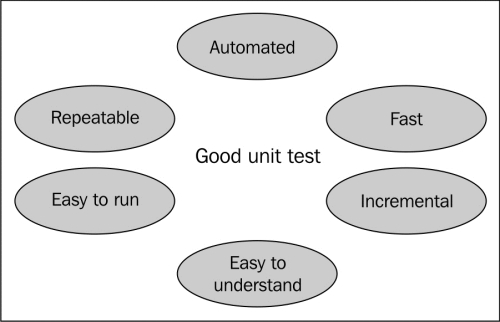Unit testing is not a new concept in the software development world. Thanks to Kent Beck, the concept of unit testing was introduced in Smalltalk , then the concept was transferred to many other programming languages, such as C, C++, and Java. The classical definition of unit testing is that it is a piece of code (usually a method) that invokes another piece of code and later checks the correctness of some assumptions.
The definition is technically correct; however, it does not show us how to make a really good unit test. In order to write a good unit test, we need to understand the requirements of a good unit test.
As shown in the following figure, a good unit test should be automated, repeatable, easy to understand, incremental, easy to run, and fast.

A good unit test should be automated and repeatable, which means that other team members can repeat running the application unit tests for every significant code change automatically. It should also be easy to understand so that other team members can understand what your test means and can continue adding more test cases or updating an existing test case. A good unit test should be incremental; this means that the unit test should be updated if a new relevant defect is detected in the code, which means that this defect will not happen again as long as this unit test is running periodically. Finally, a good unit test should be easy to run; it should run by executing a command or by clicking a button and should not take a long time for execution because fast unit tests can help in increasing the development team's productivity.
So let's go back to the definition and refine it. Unit testing is a piece of code (usually a method) that invokes another piece of code and checks the correctness of some assumptions later. Unit testing should be automated, repeatable, easy to understand, incremental, easy to run, and fast.



